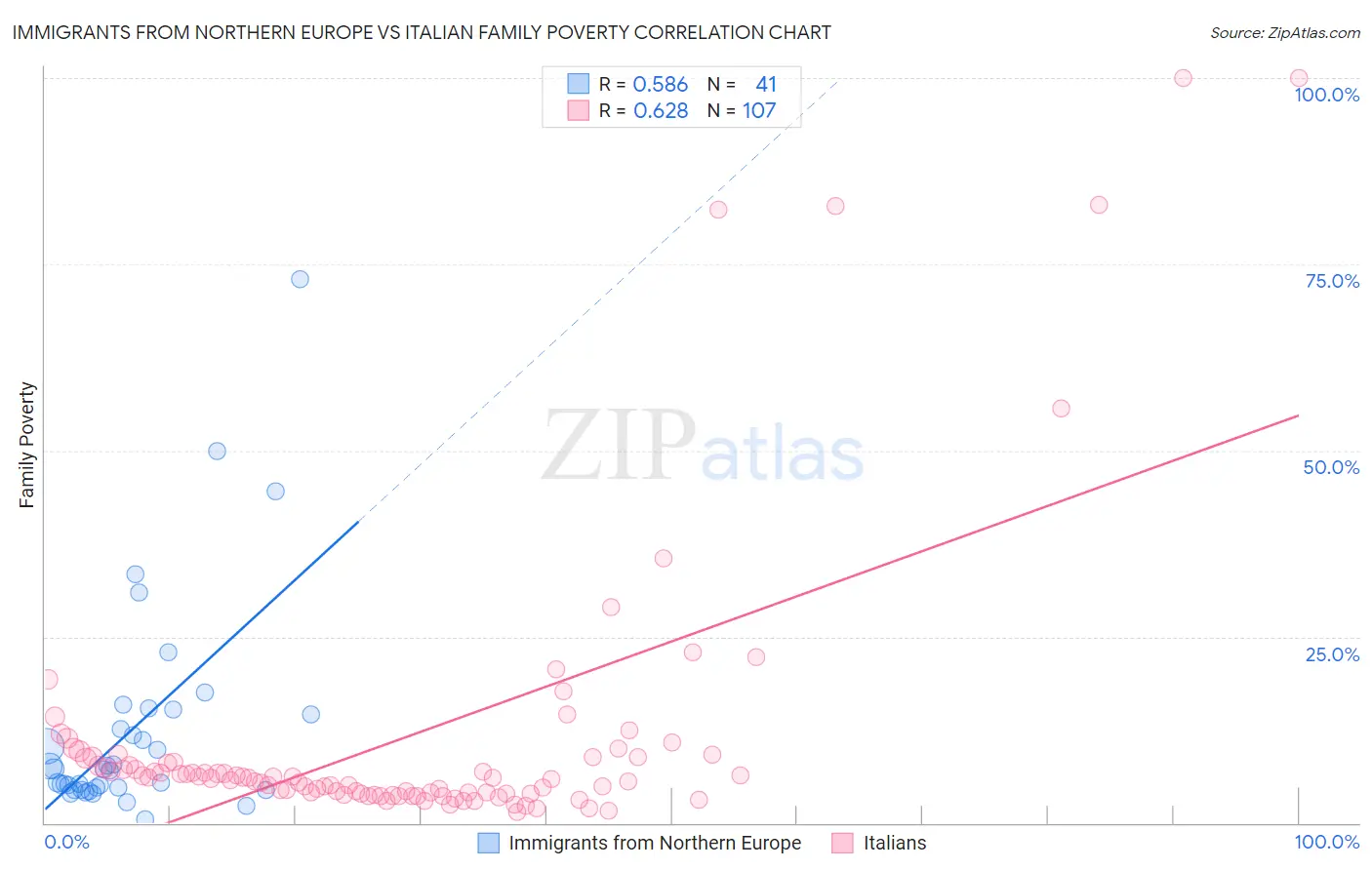Immigrants from Northern Europe vs Italian Family Poverty
COMPARE
Immigrants from Northern Europe
Italian
Family Poverty
Family Poverty Comparison
Immigrants from Northern Europe
Italians
7.4%
FAMILY POVERTY
99.6/ 100
METRIC RATING
29th/ 347
METRIC RANK
7.4%
FAMILY POVERTY
99.6/ 100
METRIC RATING
30th/ 347
METRIC RANK
Immigrants from Northern Europe vs Italian Family Poverty Correlation Chart
The statistical analysis conducted on geographies consisting of 475,098,586 people shows a substantial positive correlation between the proportion of Immigrants from Northern Europe and poverty level among families in the United States with a correlation coefficient (R) of 0.586 and weighted average of 7.4%. Similarly, the statistical analysis conducted on geographies consisting of 569,861,523 people shows a significant positive correlation between the proportion of Italians and poverty level among families in the United States with a correlation coefficient (R) of 0.628 and weighted average of 7.4%, a difference of 0.29%.

Family Poverty Correlation Summary
| Measurement | Immigrants from Northern Europe | Italian |
| Minimum | 0.50% | 1.5% |
| Maximum | 72.9% | 100.0% |
| Range | 72.4% | 98.5% |
| Mean | 12.6% | 11.4% |
| Median | 7.3% | 6.1% |
| Interquartile 25% (IQ1) | 4.6% | 4.0% |
| Interquartile 75% (IQ3) | 14.9% | 8.8% |
| Interquartile Range (IQR) | 10.3% | 4.8% |
| Standard Deviation (Sample) | 14.6% | 18.9% |
| Standard Deviation (Population) | 14.4% | 18.8% |
Demographics Similar to Immigrants from Northern Europe and Italians by Family Poverty
In terms of family poverty, the demographic groups most similar to Immigrants from Northern Europe are Immigrants from Korea (7.4%, a difference of 0.17%), Czech (7.4%, a difference of 0.41%), Immigrants from Scotland (7.3%, a difference of 0.55%), Cypriot (7.3%, a difference of 0.57%), and Polish (7.4%, a difference of 0.71%). Similarly, the demographic groups most similar to Italians are Czech (7.4%, a difference of 0.12%), Polish (7.4%, a difference of 0.42%), Immigrants from Japan (7.4%, a difference of 0.42%), Immigrants from Korea (7.4%, a difference of 0.46%), and Russian (7.5%, a difference of 0.65%).
| Demographics | Rating | Rank | Family Poverty |
| Eastern Europeans | 99.7 /100 | #19 | Exceptional 7.2% |
| Immigrants | Hong Kong | 99.7 /100 | #20 | Exceptional 7.3% |
| Immigrants | Iran | 99.7 /100 | #21 | Exceptional 7.3% |
| Danes | 99.7 /100 | #22 | Exceptional 7.3% |
| Assyrians/Chaldeans/Syriacs | 99.7 /100 | #23 | Exceptional 7.3% |
| Croatians | 99.7 /100 | #24 | Exceptional 7.3% |
| Burmese | 99.7 /100 | #25 | Exceptional 7.3% |
| Cypriots | 99.6 /100 | #26 | Exceptional 7.3% |
| Immigrants | Scotland | 99.6 /100 | #27 | Exceptional 7.3% |
| Immigrants | Korea | 99.6 /100 | #28 | Exceptional 7.4% |
| Immigrants | Northern Europe | 99.6 /100 | #29 | Exceptional 7.4% |
| Italians | 99.6 /100 | #30 | Exceptional 7.4% |
| Czechs | 99.6 /100 | #31 | Exceptional 7.4% |
| Poles | 99.5 /100 | #32 | Exceptional 7.4% |
| Immigrants | Japan | 99.5 /100 | #33 | Exceptional 7.4% |
| Russians | 99.5 /100 | #34 | Exceptional 7.5% |
| Greeks | 99.4 /100 | #35 | Exceptional 7.5% |
| Turks | 99.4 /100 | #36 | Exceptional 7.5% |
| Estonians | 99.4 /100 | #37 | Exceptional 7.5% |
| Bolivians | 99.3 /100 | #38 | Exceptional 7.5% |
| Carpatho Rusyns | 99.3 /100 | #39 | Exceptional 7.5% |